[English] 日本語
 Yorodumi
Yorodumi- PDB-1ev2: CRYSTAL STRUCTURE OF FGF2 IN COMPLEX WITH THE EXTRACELLULAR LIGAN... -
+ Open data
Open data
- Basic information
Basic information
| Entry | Database: PDB / ID: 1ev2 | ||||||
|---|---|---|---|---|---|---|---|
| Title | CRYSTAL STRUCTURE OF FGF2 IN COMPLEX WITH THE EXTRACELLULAR LIGAND BINDING DOMAIN OF FGF RECEPTOR 2 (FGFR2) | ||||||
 Components Components |
| ||||||
 Keywords Keywords | GROWTH FACTOR/GROWTH FACTOR RECEPTOR / IMMUNOGLOBULIN (IG)LIKE DOMAINS BELONGING TO THE I-SET SUBGROUP WITHIN IG-LIKE DOMAINS / B-TREFOIL FOLD / GROWTH FACTOR-GROWTH FACTOR RECEPTOR COMPLEX | ||||||
| Function / homology |  Function and homology information Function and homology informationgrowth factor dependent regulation of skeletal muscle satellite cell proliferation / positive regulation of inner ear auditory receptor cell differentiation / positive regulation of neuroepithelial cell differentiation / regulation of blood vessel endothelial cell proliferation involved in sprouting angiogenesis / positive regulation of lens fiber cell differentiation / positive regulation of endothelial cell chemotaxis to fibroblast growth factor / positive regulation of cell fate specification / regulation of retinal cell programmed cell death / Formation of intermediate mesoderm / regulation of cell migration involved in sprouting angiogenesis ...growth factor dependent regulation of skeletal muscle satellite cell proliferation / positive regulation of inner ear auditory receptor cell differentiation / positive regulation of neuroepithelial cell differentiation / regulation of blood vessel endothelial cell proliferation involved in sprouting angiogenesis / positive regulation of lens fiber cell differentiation / positive regulation of endothelial cell chemotaxis to fibroblast growth factor / positive regulation of cell fate specification / regulation of retinal cell programmed cell death / Formation of intermediate mesoderm / regulation of cell migration involved in sprouting angiogenesis / FGFRL1 modulation of FGFR1 signaling / corticotropin hormone secreting cell differentiation / thyroid-stimulating hormone-secreting cell differentiation / Signaling by FGFR2 amplification mutants / Signaling by FGFR2 fusions / fibroblast growth factor receptor signaling pathway involved in negative regulation of apoptotic process in bone marrow cell / fibroblast growth factor receptor signaling pathway involved in hemopoiesis / fibroblast growth factor receptor signaling pathway involved in positive regulation of cell proliferation in bone marrow / fibroblast growth factor receptor signaling pathway involved in mammary gland specification / lateral sprouting from an epithelium / mammary gland bud formation / branch elongation involved in salivary gland morphogenesis / mesenchymal cell differentiation involved in lung development / chondroblast differentiation / lacrimal gland development / otic vesicle formation / prostate gland morphogenesis / lymphatic endothelial cell migration /  chemokine binding / regulation of smooth muscle cell differentiation / orbitofrontal cortex development / negative regulation of fibroblast growth factor receptor signaling pathway / regulation of morphogenesis of a branching structure / squamous basal epithelial stem cell differentiation involved in prostate gland acinus development / branching morphogenesis of a nerve / POU5F1 (OCT4), SOX2, NANOG activate genes related to proliferation / embryonic organ morphogenesis / positive regulation of cerebellar granule cell precursor proliferation / endochondral bone growth / morphogenesis of embryonic epithelium / epidermis morphogenesis / bud elongation involved in lung branching / cerebellar granule cell precursor proliferation / positive regulation of epithelial cell proliferation involved in lung morphogenesis / pyramidal neuron development / positive regulation of stem cell differentiation / membranous septum morphogenesis / reproductive structure development / limb bud formation / lung lobe morphogenesis / positive regulation of epithelial tube formation / hyaluronan catabolic process / receptor-receptor interaction / regulation of endothelial cell chemotaxis to fibroblast growth factor / gland morphogenesis / fibroblast growth factor receptor signaling pathway involved in orbitofrontal cortex development / ventricular zone neuroblast division / glial cell differentiation / embryonic digestive tract morphogenesis / epithelial cell proliferation involved in salivary gland morphogenesis / negative regulation of wound healing / mesenchymal cell differentiation / inner ear auditory receptor cell differentiation / stem cell development / branching involved in prostate gland morphogenesis / Signaling by activated point mutants of FGFR3 / FGFR3c ligand binding and activation / mesenchymal cell proliferation involved in lung development / Phospholipase C-mediated cascade; FGFR3 / branching involved in labyrinthine layer morphogenesis / embryonic morphogenesis / FGFR2b ligand binding and activation / chemokine binding / regulation of smooth muscle cell differentiation / orbitofrontal cortex development / negative regulation of fibroblast growth factor receptor signaling pathway / regulation of morphogenesis of a branching structure / squamous basal epithelial stem cell differentiation involved in prostate gland acinus development / branching morphogenesis of a nerve / POU5F1 (OCT4), SOX2, NANOG activate genes related to proliferation / embryonic organ morphogenesis / positive regulation of cerebellar granule cell precursor proliferation / endochondral bone growth / morphogenesis of embryonic epithelium / epidermis morphogenesis / bud elongation involved in lung branching / cerebellar granule cell precursor proliferation / positive regulation of epithelial cell proliferation involved in lung morphogenesis / pyramidal neuron development / positive regulation of stem cell differentiation / membranous septum morphogenesis / reproductive structure development / limb bud formation / lung lobe morphogenesis / positive regulation of epithelial tube formation / hyaluronan catabolic process / receptor-receptor interaction / regulation of endothelial cell chemotaxis to fibroblast growth factor / gland morphogenesis / fibroblast growth factor receptor signaling pathway involved in orbitofrontal cortex development / ventricular zone neuroblast division / glial cell differentiation / embryonic digestive tract morphogenesis / epithelial cell proliferation involved in salivary gland morphogenesis / negative regulation of wound healing / mesenchymal cell differentiation / inner ear auditory receptor cell differentiation / stem cell development / branching involved in prostate gland morphogenesis / Signaling by activated point mutants of FGFR3 / FGFR3c ligand binding and activation / mesenchymal cell proliferation involved in lung development / Phospholipase C-mediated cascade; FGFR3 / branching involved in labyrinthine layer morphogenesis / embryonic morphogenesis / FGFR2b ligand binding and activation /  fibroblast growth factor receptor binding / angiogenesis involved in coronary vascular morphogenesis / FGFR2c ligand binding and activation / Activated point mutants of FGFR2 / regulation of osteoblast proliferation / Phospholipase C-mediated cascade; FGFR2 / FGFR4 ligand binding and activation / FGFR1b ligand binding and activation / fibroblast growth factor receptor binding / angiogenesis involved in coronary vascular morphogenesis / FGFR2c ligand binding and activation / Activated point mutants of FGFR2 / regulation of osteoblast proliferation / Phospholipase C-mediated cascade; FGFR2 / FGFR4 ligand binding and activation / FGFR1b ligand binding and activation /  fibroblast growth factor receptor activity / branching involved in salivary gland morphogenesis / mammary gland epithelial cell differentiation / Phospholipase C-mediated cascade; FGFR4 / embryonic pattern specification / outflow tract septum morphogenesis / Signaling by activated point mutants of FGFR1 / FGFR1c ligand binding and activation / organ induction / Downstream signaling of activated FGFR1 / Phospholipase C-mediated cascade: FGFR1 / positive regulation of phospholipase activity / lung-associated mesenchyme development / fibroblast growth factor receptor activity / branching involved in salivary gland morphogenesis / mammary gland epithelial cell differentiation / Phospholipase C-mediated cascade; FGFR4 / embryonic pattern specification / outflow tract septum morphogenesis / Signaling by activated point mutants of FGFR1 / FGFR1c ligand binding and activation / organ induction / Downstream signaling of activated FGFR1 / Phospholipase C-mediated cascade: FGFR1 / positive regulation of phospholipase activity / lung-associated mesenchyme development /  paracrine signaling / mesodermal cell differentiation / negative regulation of fibroblast migration / regulation of smoothened signaling pathway / embryonic cranial skeleton morphogenesis / digestive tract development / cell migration involved in sprouting angiogenesis paracrine signaling / mesodermal cell differentiation / negative regulation of fibroblast migration / regulation of smoothened signaling pathway / embryonic cranial skeleton morphogenesis / digestive tract development / cell migration involved in sprouting angiogenesisSimilarity search - Function | ||||||
| Biological species |   Homo sapiens (human) Homo sapiens (human) | ||||||
| Method |  X-RAY DIFFRACTION / X-RAY DIFFRACTION /  SYNCHROTRON / Resolution: 2.2 Å SYNCHROTRON / Resolution: 2.2 Å | ||||||
 Authors Authors | Plotnikov, A.N. / Hubbard, S.R. / Schlessinger, J. / Mohammadi, M. | ||||||
 Citation Citation |  Journal: Cell(Cambridge,Mass.) / Year: 2000 Journal: Cell(Cambridge,Mass.) / Year: 2000Title: Crystal structures of two FGF-FGFR complexes reveal the determinants of ligand-receptor specificity. Authors: Plotnikov, A.N. / Hubbard, S.R. / Schlessinger, J. / Mohammadi, M. | ||||||
| History |
|
- Structure visualization
Structure visualization
| Structure viewer | Molecule:  Molmil Molmil Jmol/JSmol Jmol/JSmol |
|---|
- Downloads & links
Downloads & links
- Download
Download
| PDBx/mmCIF format |  1ev2.cif.gz 1ev2.cif.gz | 256.1 KB | Display |  PDBx/mmCIF format PDBx/mmCIF format |
|---|---|---|---|---|
| PDB format |  pdb1ev2.ent.gz pdb1ev2.ent.gz | 209.8 KB | Display |  PDB format PDB format |
| PDBx/mmJSON format |  1ev2.json.gz 1ev2.json.gz | Tree view |  PDBx/mmJSON format PDBx/mmJSON format | |
| Others |  Other downloads Other downloads |
-Validation report
| Arichive directory |  https://data.pdbj.org/pub/pdb/validation_reports/ev/1ev2 https://data.pdbj.org/pub/pdb/validation_reports/ev/1ev2 ftp://data.pdbj.org/pub/pdb/validation_reports/ev/1ev2 ftp://data.pdbj.org/pub/pdb/validation_reports/ev/1ev2 | HTTPS FTP |
|---|
-Related structure data
- Links
Links
- Assembly
Assembly
| Deposited unit | 
| ||||||||
|---|---|---|---|---|---|---|---|---|---|
| 1 |
| ||||||||
| Unit cell |
|
- Components
Components
| #1: Protein | Mass: 15110.339 Da / Num. of mol.: 4 / Fragment: THE B-TREFOIL CORE OF FIBROBLAST GROWTH FACTOR 2 / Mutation: YES Source method: isolated from a genetically manipulated source Source: (gene. exp.)   Homo sapiens (human) / Plasmid: PET15B / Production host: Homo sapiens (human) / Plasmid: PET15B / Production host:   Escherichia coli (E. coli) / References: UniProt: P09038 Escherichia coli (E. coli) / References: UniProt: P09038#2: Protein | Mass: 24640.934 Da / Num. of mol.: 4 Fragment: EXTRACELLULAR LIGAND BINDING DOMAIN OF FGF RECEPTOR 2 CONSISTING OF IMMUNOGLOBULIN LIKE DOMAINS II (D2) AND III (D3) Source method: isolated from a genetically manipulated source Source: (gene. exp.)   Homo sapiens (human) / Plasmid: PET28A / Production host: Homo sapiens (human) / Plasmid: PET28A / Production host:   Escherichia coli (E. coli) / References: UniProt: P21802 Escherichia coli (E. coli) / References: UniProt: P21802#3: Chemical | ChemComp-SO4 /  Sulfate Sulfate#4: Water | ChemComp-HOH / |  Water Water |
|---|
-Experimental details
-Experiment
| Experiment | Method:  X-RAY DIFFRACTION / Number of used crystals: 1 X-RAY DIFFRACTION / Number of used crystals: 1 |
|---|
- Sample preparation
Sample preparation
| Crystal | Density Matthews: 2.96 Å3/Da / Density % sol: 58.41 % | ||||||||||||||||||||||||||||||||||||||||||
|---|---|---|---|---|---|---|---|---|---|---|---|---|---|---|---|---|---|---|---|---|---|---|---|---|---|---|---|---|---|---|---|---|---|---|---|---|---|---|---|---|---|---|---|
Crystal grow | Temperature: 298 K / Method: vapor diffusion / pH: 7.5 Details: PEG 4000, Isopropanol, HEPES-NaOH, pH 7.5, VAPOR DIFFUSION, temperature 298.0K | ||||||||||||||||||||||||||||||||||||||||||
| Crystal grow | *PLUS Method: vapor diffusion, hanging dropDetails: drop consists of equal volume of protein and reservoir solutions | ||||||||||||||||||||||||||||||||||||||||||
| Components of the solutions | *PLUS
|
-Data collection
| Diffraction | Mean temperature: 110 K |
|---|---|
| Diffraction source | Source:  SYNCHROTRON / Site: SYNCHROTRON / Site:  NSLS NSLS  / Beamline: X4A / Wavelength: 0.9789 / Beamline: X4A / Wavelength: 0.9789 |
| Detector | Type: SDMS / Detector: AREA DETECTOR / Date: Sep 22, 1999 |
| Radiation | Protocol: SINGLE WAVELENGTH / Monochromatic (M) / Laue (L): M / Scattering type: x-ray |
| Radiation wavelength | Wavelength : 0.9789 Å / Relative weight: 1 : 0.9789 Å / Relative weight: 1 |
| Reflection | Resolution: 2.2→25 Å / Num. obs: 206913 / % possible obs: 96.3 % / Observed criterion σ(I): 0 / Redundancy: 2.2 % / Rmerge(I) obs: 0.042 / Net I/σ(I): 16.3 |
| Reflection shell | Resolution: 2.2→2.28 Å / Rmerge(I) obs: 0.241 / % possible all: 87.8 |
| Reflection | *PLUS Num. obs: 93440 / Num. measured all: 206913 |
| Reflection shell | *PLUS % possible obs: 87.8 % |
- Processing
Processing
| Software |
| ||||||||||||||||||||||||||||||||||||||||||||||||||||||||||||||||||||||||||||||||
|---|---|---|---|---|---|---|---|---|---|---|---|---|---|---|---|---|---|---|---|---|---|---|---|---|---|---|---|---|---|---|---|---|---|---|---|---|---|---|---|---|---|---|---|---|---|---|---|---|---|---|---|---|---|---|---|---|---|---|---|---|---|---|---|---|---|---|---|---|---|---|---|---|---|---|---|---|---|---|---|---|---|
| Refinement | Resolution: 2.2→25 Å / σ(F): 0 / Stereochemistry target values: ENGH & HUBER
| ||||||||||||||||||||||||||||||||||||||||||||||||||||||||||||||||||||||||||||||||
| Solvent computation | Solvent model: CNS / Bsol: 47.84 Å2 / ksol: 0.382 e/Å3 | ||||||||||||||||||||||||||||||||||||||||||||||||||||||||||||||||||||||||||||||||
| Displacement parameters |
| ||||||||||||||||||||||||||||||||||||||||||||||||||||||||||||||||||||||||||||||||
| Refinement step | Cycle: LAST / Resolution: 2.2→25 Å
| ||||||||||||||||||||||||||||||||||||||||||||||||||||||||||||||||||||||||||||||||
| Refine LS restraints |
| ||||||||||||||||||||||||||||||||||||||||||||||||||||||||||||||||||||||||||||||||
| Software | *PLUS Name: 'CNS' / Classification: refinement | ||||||||||||||||||||||||||||||||||||||||||||||||||||||||||||||||||||||||||||||||
| Refine LS restraints | *PLUS
|
 Movie
Movie Controller
Controller


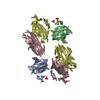
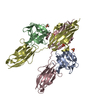




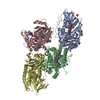

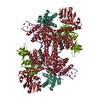
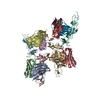
 PDBj
PDBj











